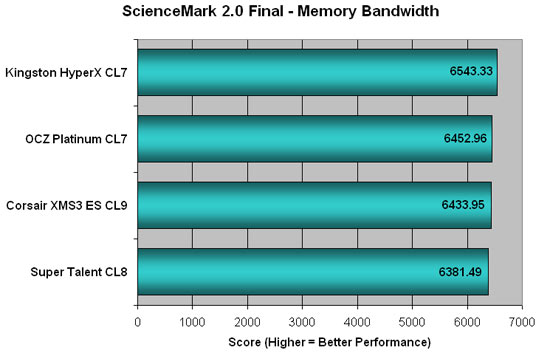Corsair, Kingston, OCZ & Super Talent DDR3 Roundup
Sciencemark and STALKER
ScienceMark 2.0 Final:
Science Mark 2.0 is an attempt to put the truth behind benchmarking. In an attempt to model real world demands and performance, ScienceMark 2.0 is a suite of high-performance benchmarks that realistically stress system performance without architectural bias. All of our testing was completed on the 32 Bit Final benchmark version that is dated March 21st 2005.

Results: In Sciencemark 2 the memory bandwidth test showed the benefits of tighter timings with the exception of the Super Talent kit. The Super Talent kit has placed behind the Cosair XMS3 kit with looser timings a number of times now, which might mean the PCB that Super Talent is using or some SPD settings are impacting the level of performance.
S.T.A.L.K.E.R.: Shadow of Chernobyl
S.T.A.L.K.E.R.: Shadow of Chernobyl uses the ‘X-ray Engine’ to power the graphics. It is a DirectX 8/9 Shader Model 3.0 graphics engine. Up to a million polygons can be on-screen at any one time, which makes it one of the more impressive engines on the market today. The engine features HDR rendering, parallax and normal mapping, soft shadows, widescreen support, weather effects and day/night cycles. As with other engines that utilize deferred shading (such as Unreal Engine 3 and CryENGINE2), the X-ray Engine does not support anti-aliasing with dynamic lighting enabled. However, a “fake” form of anti-aliasing can be enabled with the static lighting option; this format utilizes a technique to blur the image to give the false impression of anti-aliasing. The game takes place in a thirty square kilometer area, and both the outside and inside of this area is rendered to the same amount of detail.

Results: At the default 1024×768 game resolution and game settings we found that S.T.A.L.K.E.R.: Shadow of Chernobyl was more than playable on with DDR3 1333MHz memory modules on the P35 chipset. Less than a two frame per second difference was observed between the four brands of memory and although one would expect that CL7 based memory would blow a CL9 based kit away that wasn’t the case here. We ran the benchmark six times per kit and took the average of the score, so the results are spot on!


Comments are closed.